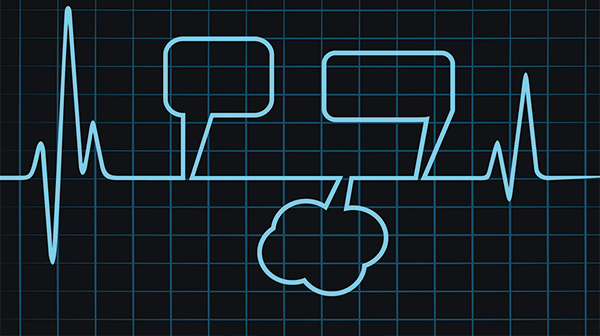
Catch up on some of emergency medicine’s best tweets and learn to pack a punch into 140 characters
Explore This Issue
ACEP Now: Vol 33 – No 02 – February 2014Not addicted to Twitter yet? Not a problem. Here are five recent tweets that’ll give you a sense of what is going on in the emergency medicine Twitterverse.
 1. Graham Walker, MD (@grahamwalker), an emergency physician in San Francisco, asked: “Any pearls/tricks/tips on how people are using their smartphones in the ER?” Dr. Walker is the perfect person to initiate this conversation; his MDCalc website, soon to be an app, is a hugely popular smartphone tool for a variety of clinical uses, providing checklists for clinical decision tools and calculations you can’t quite remember. (Corrected calcium, anyone?) Replies covered a range of tricks that would have made MacGyver proud. Teresa Chan, MD (@TChanMD), an emergency physician with Hamilton Health Sciences in Ontario, replied that she has seen videos of pediatric seizures provided by parents. Seth Trueger, MD (@MDaware), an emergency physician and health-policy fellow at George Washington University in Washington, DC, apparently gets a lot of use out of his smartphone for “Derm tele-consults; [Snellen] eye chart; Patients take pics of their own lesions, ECGs; [I] show parents PECARN algorithm; a metronome for CPR.” Others chimed in, saying they use their phones for keeping important papers handy. Personally, I use checklists and Siri reminders for following up on labs and the camera for taking photographs of medication lists (always with patient permission). And, of course, there is the indispensable flashlight: the ultimate smartphone “PERRL.”
1. Graham Walker, MD (@grahamwalker), an emergency physician in San Francisco, asked: “Any pearls/tricks/tips on how people are using their smartphones in the ER?” Dr. Walker is the perfect person to initiate this conversation; his MDCalc website, soon to be an app, is a hugely popular smartphone tool for a variety of clinical uses, providing checklists for clinical decision tools and calculations you can’t quite remember. (Corrected calcium, anyone?) Replies covered a range of tricks that would have made MacGyver proud. Teresa Chan, MD (@TChanMD), an emergency physician with Hamilton Health Sciences in Ontario, replied that she has seen videos of pediatric seizures provided by parents. Seth Trueger, MD (@MDaware), an emergency physician and health-policy fellow at George Washington University in Washington, DC, apparently gets a lot of use out of his smartphone for “Derm tele-consults; [Snellen] eye chart; Patients take pics of their own lesions, ECGs; [I] show parents PECARN algorithm; a metronome for CPR.” Others chimed in, saying they use their phones for keeping important papers handy. Personally, I use checklists and Siri reminders for following up on labs and the camera for taking photographs of medication lists (always with patient permission). And, of course, there is the indispensable flashlight: the ultimate smartphone “PERRL.”
 2. From Reuben Strayer, MD (@emupdates), assistant clinical professor of emergency medicine at the Icahn School of Medicine at Mount Sinai in New York City: “Use ketamine fearlessly, even recklessly, by understanding the ketamine brain continuum. goo.gl/XGQxTj #emupdates.” This tweet went viral, garnering more than 40 retweets to thousands of people. Dr. Strayer’s postings on his website, EMupdates.com, are always full of supporting resources, including links to high-quality research papers, flow charts, checklists, and screencasts that walk you through everything you need to know. Any fears you may have about ketamine’s safety profile and managing potential emergency reactions from ketamine for procedural sedation are soundly put to rest here, with ample evidence and crystal-clear rationale covering everything from physiology to practice-based guidance. Dr. Strayer’s website may be one of the best-kept secrets in the FOAM (Free Open Access Meducation) world. He doesn’t do a lot of self-promotion, but insiders know he’s a FOAMer’s FOAMite.
2. From Reuben Strayer, MD (@emupdates), assistant clinical professor of emergency medicine at the Icahn School of Medicine at Mount Sinai in New York City: “Use ketamine fearlessly, even recklessly, by understanding the ketamine brain continuum. goo.gl/XGQxTj #emupdates.” This tweet went viral, garnering more than 40 retweets to thousands of people. Dr. Strayer’s postings on his website, EMupdates.com, are always full of supporting resources, including links to high-quality research papers, flow charts, checklists, and screencasts that walk you through everything you need to know. Any fears you may have about ketamine’s safety profile and managing potential emergency reactions from ketamine for procedural sedation are soundly put to rest here, with ample evidence and crystal-clear rationale covering everything from physiology to practice-based guidance. Dr. Strayer’s website may be one of the best-kept secrets in the FOAM (Free Open Access Meducation) world. He doesn’t do a lot of self-promotion, but insiders know he’s a FOAMer’s FOAMite.
 3. From St. Emlyn’s co-founder and Emergency Medicine Journal Editor Simon Carley, MD (@EMManchester), comes a great journal club entry: “Family presence for Brain Death Evaluation. Should families be present for brain stem testing? http://stemlynsblog.org/
3. From St. Emlyn’s co-founder and Emergency Medicine Journal Editor Simon Carley, MD (@EMManchester), comes a great journal club entry: “Family presence for Brain Death Evaluation. Should families be present for brain stem testing? http://stemlynsblog.org/
jc-family-presence-brain-death-evaluation-st-emlyns.” The St. Emlyn’s blog is another terrific resource. All cases take place at the fictional and eponymously named hospital in the equally fictitious town of Virchester in the United Kingdom. This tweet links to a post that discusses a new, randomized, controlled trial published in the December 2013 issue of Critical Care Medicine. In this study, families were randomized to either be present or not during brain-death evaluations. The take home: families who were present for brain-death evaluations better understood their loved one’s prognosis without any adverse effect on their psychological well-being.
 4. Australian emergency physician Andrew Tagg, BSC, MBBS, MRCSEd (@AndrewJTagg), tweeted: “Cheers to @RAGEpodcast for making my drive into work much more entertaining and educational and for inspiring me to be even better in 2014.” Others hopping on the bandwagon is New York University/Bellevue emergency medicine residency Assistant Program Director Anand Swaminathan, MD, MPH (@EMSwami). Dr. Swami is “loving the @RAGEpodcast – great format w/ expert opinions.” The RAGE Podcast (that’s “The Resuscitationist’s Awesome Guide to Everything”) published its inaugural episode after months of hype. I know: FOAM does not need yet another podcast, except for this one. From the Aussies who brought you the “Life in the Fastlane” blog (the leading emergency medicine site in the world) comes a first-rate podcast to go with it. As the sole American on the podcast to date, critical care guru Haney Mallemat, MD (@CriticalCareNow), assistant professor of emergency medicine at the University of Maryland in Baltimore, represents us with excellence. Grab it for free on iTunes.
4. Australian emergency physician Andrew Tagg, BSC, MBBS, MRCSEd (@AndrewJTagg), tweeted: “Cheers to @RAGEpodcast for making my drive into work much more entertaining and educational and for inspiring me to be even better in 2014.” Others hopping on the bandwagon is New York University/Bellevue emergency medicine residency Assistant Program Director Anand Swaminathan, MD, MPH (@EMSwami). Dr. Swami is “loving the @RAGEpodcast – great format w/ expert opinions.” The RAGE Podcast (that’s “The Resuscitationist’s Awesome Guide to Everything”) published its inaugural episode after months of hype. I know: FOAM does not need yet another podcast, except for this one. From the Aussies who brought you the “Life in the Fastlane” blog (the leading emergency medicine site in the world) comes a first-rate podcast to go with it. As the sole American on the podcast to date, critical care guru Haney Mallemat, MD (@CriticalCareNow), assistant professor of emergency medicine at the University of Maryland in Baltimore, represents us with excellence. Grab it for free on iTunes.
 5. (@M_Lin), editor in chief of Academic Life in Emergency Medicine (ALiEM): “Thank you ALiEM expert peer reviewers for 2013 – an all-star list. http://academiclifeinem.com/thank-you-expert-peer-reviewers/.” One perceived problem with FOAM is quality control: Google can’t distinguish between a reliable source and a shady one, so a search can lead the curious learner astray. The staff at ALiEM is attempting to tackle this head on. Dr. Lin’s tweet links to a post by Natalie DeSouza, MD (@n_desouza), a senior emergency-medicine resident at the University of California at San Francisco and resident editor of ALiEM. It details how ALiEM is adopting an ad hoc and ad-libbed “expert peer-review” process. In the new system, a piece can be published on the website without expert peer review; however, if a number of experts voluntarily support it, a post hoc stamp of approval can be appended to the article. The link lists the experts who have participated in this process so far. The names should impress the editors of any of our top journals because there is substantial overlap! In addition, Brent Thoma, MD (@Brent_Thoma), an emergency medicine resident at the University of Saskatchewan, recently proposed another partial solution to the problem of gauging FOAM quality: a social media index. (See his post at http://academiclifeinem.com/social-media-index/.) Both a strength and a flaw of Dr. Thoma’s index is that it hinges on popularity. Real-time feedback and popularity may seem to indicate quality on one hand; people vote over time with their repeat visits. On the other hand, a posting on an already-popular website can be both wrong and frequently viewed, a dangerous combination for the index.
5. (@M_Lin), editor in chief of Academic Life in Emergency Medicine (ALiEM): “Thank you ALiEM expert peer reviewers for 2013 – an all-star list. http://academiclifeinem.com/thank-you-expert-peer-reviewers/.” One perceived problem with FOAM is quality control: Google can’t distinguish between a reliable source and a shady one, so a search can lead the curious learner astray. The staff at ALiEM is attempting to tackle this head on. Dr. Lin’s tweet links to a post by Natalie DeSouza, MD (@n_desouza), a senior emergency-medicine resident at the University of California at San Francisco and resident editor of ALiEM. It details how ALiEM is adopting an ad hoc and ad-libbed “expert peer-review” process. In the new system, a piece can be published on the website without expert peer review; however, if a number of experts voluntarily support it, a post hoc stamp of approval can be appended to the article. The link lists the experts who have participated in this process so far. The names should impress the editors of any of our top journals because there is substantial overlap! In addition, Brent Thoma, MD (@Brent_Thoma), an emergency medicine resident at the University of Saskatchewan, recently proposed another partial solution to the problem of gauging FOAM quality: a social media index. (See his post at http://academiclifeinem.com/social-media-index/.) Both a strength and a flaw of Dr. Thoma’s index is that it hinges on popularity. Real-time feedback and popularity may seem to indicate quality on one hand; people vote over time with their repeat visits. On the other hand, a posting on an already-popular website can be both wrong and frequently viewed, a dangerous combination for the index.
 Jeremy Samuel Faust MD, MS, MA, is an emergency-medicine resident at Mount Sinai Hospital in New York and Elmhurst Hospital Center in Queens. He tweets about #FOAMed and classical music @jeremyfaust.
Jeremy Samuel Faust MD, MS, MA, is an emergency-medicine resident at Mount Sinai Hospital in New York and Elmhurst Hospital Center in Queens. He tweets about #FOAMed and classical music @jeremyfaust.
Pages: 1 2 3 | Multi-Page





No Responses to “ED Physicians Tweet About eTools, Ketamine, Evaluating Brain Death, and Free Open Access Meducation (FOAM)”